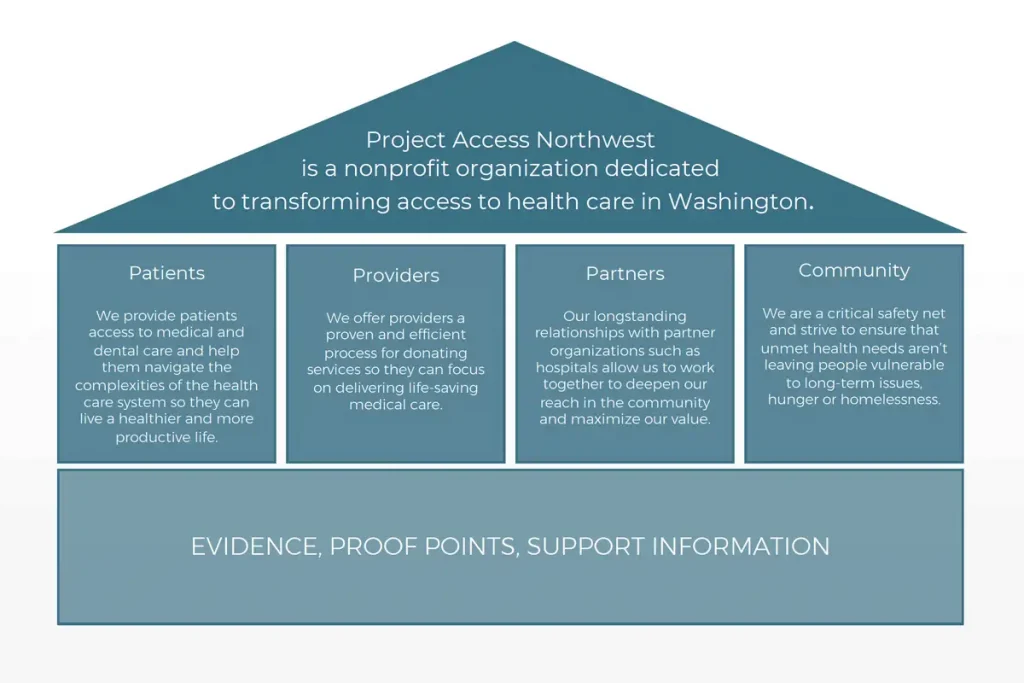Insights
A Guide to Building Unified Healthcare Messaging for Organizations
There is no industry more complex than healthcare. Often times, a healthcare communicator can find themselves in enough messages and proof points to boil the ocean. And too many messaging priorities can cause brand confusion and watered-down storytelling. We recently worked with one of our healthcare clients, Project Access Northwest, to help them distill their story into a unified brand message. The goal was to prioritize storytelling, articulate who they are and what they stand for, and differentiate them from other organizations in this space.
Following are four steps that you can use to develop healthcare messaging that will resonate with an organization’s stakeholders and their target audiences:
Hold a discovery meeting
Before developing a healthcare messaging platform, it is important to conduct a discovery meeting with the organization. This will allow you to gauge their perceptions of the current state of their communications, identify their key stakeholders, and pinpoint particular areas of interest they’d like to learn more about. It will also help to establish a baseline of communication and provide insight about what matters most to them.
Conduct messaging research
Research is key to a solid healthcare messaging platform. The research tactics that work best for a healthcare organization can vary case by case. However, we recommend utilizing an online survey through Survey Monkey or a similar platform. This is a cost-effective, reliable, and easy way to execute research. Regardless of the research approach, it is important that the tactics elicit qualitative data. For example, you may glean the associations participants have with the organization, their mission, their work, etc. The goal of this qualitative approach is to identify key issues, messaging themes, story angles and brand advocates.
Some questions to ask are:
- What do you feel is the biggest value the organization provides?
- How is the organization different from others in the healthcare community?
- What do you feel is the organization’s role in the community?
Guide brainstorm sessions
After all the data is gathered, the next step is to lead collaborative brainstorm sessions. Brainstorming helps an organization’s team analyze all the survey data and make it more manageable. To maximize the number of ideas generated and receive stakeholder “buy-in”, conduct two separate brainstorming sessions—first with key internal stakeholders and then with the organization’s communications team.
Some brainstorm questions to ask:
- What key adjectives describe your organization?
- How would you describe what your organization is not?
- What should people know about your organization?
Session #1 should include key internal stakeholders, such as staff, board members, and third-party partners. When stakeholders participate in a brainstorming session, they can better understand the importance of message development and “buy-in” to the project. The purpose of this session is to have the stakeholders think deeply about what their organization is, what it isn’t, and where they would like to see it go in the future.
Session #2 should include the organization’s marketing and/or public relations team. By reviewing research findings and takeaways from the internal stakeholder brainstorming session, your team can begin to discern common themes, terms, ideas, and areas for communication improvements. These commonalities will be the foundation of the healthcare messaging platform. For our particular client, we developed a message house, a list of the top six brand words, and an elevator pitch.
Utilize healthcare messaging platform for communications moving forward
Once the messaging platform is approved, it can be utilized for all internal and external communications. The unified message strategy will ensure all communications are rooted in the organization’s primary messages. Storytelling using primary messages will help reinforce why the organization exists, and why it’s unique.

